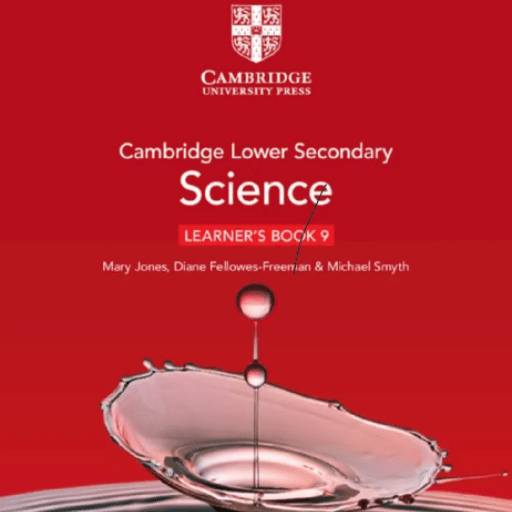
|
INFINITY COURSE
Year 9 Lower Secondary Science (Cambridge)Keystone Instructors · Last updated on Mar 27, 2025 |
Year 9 Lower Secondary Science (Cambridge) Study Material
Year 9 Lower Secondary Science (Cambridge) Exam Pattern 2025-2026
Year 9 Lower Secondary Science (Cambridge) Exam Pattern for Year 9
The Year 9 Lower Secondary Science exam under the Cambridge curriculum is designed to assess students' understanding and application of scientific concepts. Below is a detailed overview of the exam pattern:
1. Exam Structure
- Number of Papers: Typically, there are two main papers for the Year 9 Science exam.
- Paper 1: Focuses on multiple-choice questions and short answer questions.
- Paper 2: Involves structured questions that require deeper understanding and application of scientific knowledge.
2. Topics Covered
- Biology: Cells, human anatomy, ecosystems, and basic genetics.
- Chemistry: States of matter, chemical reactions, and the periodic table.
- Physics: Forces, energy, motion, and basic principles of electricity.
3. Exam Duration
- Paper 1 Duration: Approximately 1 hour.
- Paper 2 Duration: Approximately 1 hour and 30 minutes.
4. Assessment Objectives
- Knowledge and Understanding: Evaluate students' grasp of scientific facts and concepts.
- Application: Assess students' ability to apply their knowledge to new scenarios.
- Analysis and Evaluation: Test students' skills in analyzing data and making reasoned conclusions.
5. Grading System
- Grades: Students are typically graded on a scale (e.g., A to U), with A being the highest grade.
- Weightage: Each paper contributes to the overall grade, with specific weightage determined by the examining body.
6. Preparation Tips
- Regular Revision: Consistently review all topics covered throughout the year.
- Practice Past Papers: Familiarize yourself with the exam format by working on past papers.
- Understand Key Concepts: Focus on understanding the 'why' behind scientific principles, rather than rote memorization.
By understanding the Year 9 Lower Secondary Science exam pattern, students can prepare effectively and approach their exams with confidence.
Year 9 Lower Secondary Science (Cambridge) Syllabus 2025-2026 PDF Download
Year 9 Lower Secondary Science (Cambridge) Syllabus Overview
This article presents a detailed syllabus for Year 9 Lower Secondary Science, following the Cambridge curriculum. The curriculum is designed to foster a deep understanding of fundamental scientific concepts through engaging topics. Each area of study emphasizes inquiry, experimentation, and real-world application, providing students with a solid foundation in science.
Year 9 Photosynthesis and The Carbon Cycle
- Understanding the process of photosynthesis
- Importance of photosynthesis in ecosystems
- The significance of the carbon cycle
- Human impact on the carbon cycle
- Practical experiments on photosynthesis
Year 9 Properties of Materials
- Classification of materials: solids, liquids, gases
- Physical and chemical properties of materials
- Changes of state: melting, boiling, and freezing
- Applications of materials in everyday life
- Laboratory investigations on material properties
Year 9 Forces and Energy
- Basic concepts of force and motion
- Newton’s laws of motion
- Types of forces: contact and non-contact
- Energy forms: kinetic, potential, thermal, etc.
- Conservation of energy principle
- Practical applications and experiments with forces
Year 9 Maintaining Life
- Overview of human body systems
- The importance of nutrition and exercise
- Homeostasis and its role in maintaining health
- Disease prevention and health promotion
- Experiments related to human biology
Year 9 Reactivity
- Understanding chemical reactions and equations
- Factors affecting reactivity: temperature, concentration, surface area
- Introduction to acids, bases, and pH scale
- Everyday examples of chemical reactivity
- Laboratory experiments on reactions
Year 9 Sound and Space
- Properties of sound: pitch, volume, and speed
- The science of sound waves and their behavior
- Basics of astronomy and the solar system
- The role of gravity in space
- Investigating sound through experiments
Year 9 Genes and Inheritance
- Introduction to genetics and heredity
- Structure of DNA and its function
- Mendelian genetics: dominant and recessive traits
- Applications of genetics in modern science
- Ethical considerations in genetic research
Year 9 Rates of Reaction
- Factors influencing the rates of chemical reactions
- Measuring reaction rates through experiments
- Graphical representation of reaction rates
- Real-life applications of reaction rates in industry
- Investigative projects on reaction dynamics
Year 9 Electricity
- Fundamentals of electric charge and current
- Understanding circuits: series and parallel
- Ohm’s law and its applications
- Safety precautions in electrical experiments
- Practical investigations involving electricity
Conclusion
This Year 9 Lower Secondary Science syllabus provides a comprehensive overview of essential scientific concepts and principles. Each unit is designed to engage students through hands-on experiments and real-world applications, aligning with the Cambridge curriculum standards. Emphasizing inquiry-based learning, this syllabus aims to inspire a passion for science among students as they explore the natural world.
This course is helpful for the following exams: Class 9, Year 9
How to Prepare Year 9 Lower Secondary Science (Cambridge)?
How to Prepare Year 9 Lower Secondary Science (Cambridge) for Year 9?
Preparing for Year 9 Lower Secondary Science (Cambridge) requires a strategic approach to ensure that students grasp fundamental concepts and are ready to tackle the curriculum effectively. Here are some key strategies to help students excel in Year 9 Lower Secondary Science (Cambridge).
1. Understand the Curriculum Framework
To excel in Year 9 Lower Secondary Science (Cambridge), it is crucial to familiarize yourself with the curriculum framework. This includes:
- Key Topics: Ensure you know the major topics covered, such as biology, chemistry, and physics.
- Learning Objectives: Focus on the specific learning objectives set out by the Cambridge framework.
2. Develop a Study Schedule
Creating a structured study schedule is vital for success in Year 9 Lower Secondary Science (Cambridge). Consider the following:
- Daily Study Sessions: Allocate specific times each day for studying science topics.
- Revision Periods: Build in time for periodic reviews to reinforce knowledge.
3. Utilize Quality Resources
Using high-quality resources is essential for mastering Year 9 Lower Secondary Science (Cambridge). This can include:
- Textbooks: Choose recommended textbooks aligned with the Cambridge syllabus.
- Supplementary Materials: Explore additional resources like practice papers and revision guides.
4. Engage in Practical Activities
Hands-on learning is an integral part of Year 9 Lower Secondary Science (Cambridge). Engage in practical activities by:
- Laboratory Experiments: Participate in lab sessions to apply theoretical knowledge.
- Field Studies: Explore real-world applications through fieldwork related to science topics.
5. Collaborate with Peers
Studying with peers can enhance understanding of Year 9 Lower Secondary Science (Cambridge). Consider:
- Study Groups: Form study groups to discuss and clarify challenging concepts.
- Peer Teaching: Take turns teaching each other to reinforce learning.
6. Practice Past Papers
Practicing past exam papers is a crucial step in preparing for Year 9 Lower Secondary Science (Cambridge). Focus on:
- Exam Format: Familiarize yourself with the format and types of questions asked.
- Time Management: Practice completing papers within the allocated time to improve your pacing.
7. Seek Help When Needed
Don’t hesitate to seek help when you encounter difficulties in Year 9 Lower Secondary Science (Cambridge). This can involve:
- Teacher Support: Reach out to your teachers for clarification on complex topics.
- Tutoring: Consider hiring a tutor for additional guidance if necessary.
Conclusion
Preparing for Year 9 Lower Secondary Science (Cambridge) involves a combination of structured study, practical engagement, and collaboration with peers. By following these strategies, students can build a solid foundation and confidence, leading to success in their science education journey.
Importance of Year 9 Lower Secondary Science (Cambridge)
Importance of Year 9 Lower Secondary Science (Cambridge) Course for Year 9
The Year 9 Lower Secondary Science (Cambridge) Course offered by EduRev plays a crucial role in shaping students' understanding of scientific concepts and their application in everyday life. Below are several key points highlighting its importance:
1. Foundation for Future Studies
This course provides a solid foundation in science that is essential for higher secondary education. It prepares students for more advanced topics in physics, chemistry, and biology in the years to come.
2. Development of Critical Thinking Skills
Through engaging experiments and problem-solving activities, students enhance their analytical and critical thinking skills, enabling them to approach scientific questions methodically.
3. Encouragement of Curiosity and Discovery
The curriculum is designed to spark curiosity, encouraging students to explore scientific phenomena and understand the world around them.
4. Integration of Practical Learning
Hands-on experiments and practical applications of scientific theories are integral to the course, allowing students to apply what they learn in real-world scenarios.
5. Promotion of Collaboration and Teamwork
Many activities in this course require collaboration, fostering teamwork and communication skills that are essential in both academic and professional settings.
6. Alignment with Global Standards
The Year 9 Lower Secondary Science course follows the Cambridge curriculum, ensuring that students are receiving an education that meets international standards.
7. Preparation for Assessments
With a focus on the Cambridge assessment framework, students become familiar with the exam formats and expectations, enhancing their preparedness for future evaluations.
8. Emphasis on Environmental Awareness
The course includes discussions on sustainability and environmental issues, cultivating awareness and responsibility towards the planet among young learners.
9. Encouragement of Lifelong Learning
The skills and knowledge gained from this course encourage students to pursue lifelong learning in science and related fields, fostering a sense of curiosity and inquiry.
Conclusion
The Year 9 Lower Secondary Science (Cambridge) Course offered by EduRev is instrumental in not only providing essential scientific knowledge but also in developing skills that are vital for personal and academic growth. By engaging students through a variety of learning methods, this course lays the groundwork for future success in science and beyond.
Year 9 Lower Secondary Science (Cambridge) FAQs
| 1. What are the main topics covered in Year 9 Lower Secondary Science (Cambridge)? |  |
| 2. How is the Year 9 Lower Secondary Science exam structured? |  |
| 3. What skills are developed through the Year 9 Lower Secondary Science curriculum? |  |
| 4. How can I prepare effectively for the Year 9 Lower Secondary Science exam? |  |
| 5. Are there any practical assessments in the Year 9 Lower Secondary Science exam? |  |
| 6. What resources are available to help study for the Year 9 Lower Secondary Science exam? |  |
| 7. How can I improve my understanding of biology in Year 9 Science? |  |
| 8. What role does chemistry play in the Year 9 Lower Secondary Science curriculum? |  |
| 9. How important is understanding physics in Year 9 Science? |  |
| 10. Can Year 9 Lower Secondary Science help in future studies? |  |
| 11. What are some common misconceptions in Year 9 Science topics? |  |
| 12. How can students effectively work on their practical science skills? |  |
| 13. What is the significance of environmental science in Year 9? |  |
| 14. How can students evaluate their progress in Year 9 Science? |  |
| 15. What should students do if they find a topic in Year 9 Science difficult? |  |
































